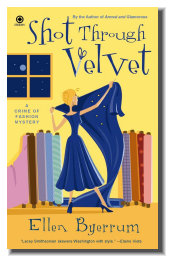
The velvet was woven with the soft nap connecting two heavier sheets of backing material. Sykes had been
the one who sheared the woven material in half, producing two sheets of velvet with the nap exposed. Scars on Sykes's hands and face
testified to the sharpness of the huge blades he used.
"Why, Mr. Blue looks like one of them troll dolls,
only not as cute," Inez Garcia said, after catching her breath.
A pretty Hispanic woman about thirty-five, Inez barely topped five feet, but she fearlessly stepped right up to get a better look at the dead man. She held on to her long, black braid to protect it from the dye.
A pretty Hispanic woman about thirty-five, Inez barely topped five feet, but she fearlessly stepped right up to get a better look at the dead man. She held on to her long, black braid to protect it from the dye.
Like most of the other workers, Inez was dressed as if for summer:
shorts and a thin cotton top. The shearing machines, the washers, dyers, and dryers pumped out heat and made the factory almost tropical
inside, in sharp contrast to the bleak Virginia winter outside. It must have been almost ninety degrees in the dye house.
"That looks like a goat-sucking chupacabra to me," Sykes said.
"That's no chupacabra. It's a coyote with mange," Inez responded. "Blue mange."
"I always wondered what'd happen if you fell in the dye vat," observed Hank Richards, the maintenance chief. "Now we know. I guess he's been in there a while."
"That's no chupacabra. It's a coyote with mange," Inez responded. "Blue mange."
"I always wondered what'd happen if you fell in the dye vat," observed Hank Richards, the maintenance chief. "Now we know. I guess he's been in there a while."
Richards appeared to be
in his late forties, tall and fit with a soldier’s bearing but an aging surfer dude's shaggy blond hair, mustache, and goatee. He
wore a navy short-sleeve polo shirt with dark blue slacks, which were neat and tidy. He had sad brown eyes that watched everything,
and he had reached out to Kira Evans when she screamed.
Everyone fell silent for a moment. They seemed to
know who the dead man was, but no one was quite ready to say so. Perhaps because he was so changed from life? The velvet factory workers
had never seen anything like the blue body before, and they were unlikely to again. Not just because murder was rare in that rural
part of Virginia, but also because their jobs in the factory were lost and gone forever.
Lacey Smithsonian had never witnessed anything like the blue man either. She'd seen a few dead bodies—bloody ones, cold ones, and
ones with terminally bad haircuts—but none like this. She held her breath, her heart beating wildly. It was a last day of work no
one here would ever forget. The ruined velvet was more than the last batch of the day: It was the last batch. The final spool of Dominion
Velvet ever to be dyed at this factory. And now Lacey had missed her chance to see how the dyeing process actually worked from start
to finish. This was the finish.
As Dominion Velvet General Manager Tom Nicholson
had put it earlier, "The world keeps on getting smaller. You see, Ms. Smithsonian, making velvet isn't just a manufacturing operation.
It's more of an art, and very labor-intensive. It's expensive to produce."
When Lacey asked about the
new plan for the factory that Rod Gibbs had mentioned, Nicholson said that was a fantasy. In better days, the factory had close to
a hundred looms and more than a hundred workers. Now it was just a ghost of its former glory. The half-dyed spool of velvet was a
reminder that dyeing the last batch of "greige goods," the cream-colored, undyed fabric, was the final task on this ultimate day of
full operations.
Dominion Velvet had picked this bitter cold Monday in February to let their factory
workers go, supposedly to avoid the deeper depression that comes with shutting down at the end of the week, according to Nicholson.
"I don't understand it either," he had told her and Vic in the office. "Some psychobabble mumbo jumbo. My people aren't any happier to be let go on the first day of the week than the last, far as I can tell."
"I don't understand it either," he had told her and Vic in the office. "Some psychobabble mumbo jumbo. My people aren't any happier to be let go on the first day of the week than the last, far as I can tell."
Once the fabric of kings and
queens, of luxury and wealth, velvet was subject to the whims of fashion and the hard economics of trade. Like Dorothy Parker's ode
to a satin dress, velvet too had the ability to soothe and comfort and "ease a heart." Nothing was as deeply textured or as warm or
as comforting as velvet. [cont.]
Shot Through Velvet, Chapter 1, continued
A latecomer to the party joined the tour. Kira Evans, the
bookkeeper, screamed and clapped her hand over her mouth. She looked ashen. A nearby worker reached out to prop her up.
Another woman gasped, "Oh my God. Is he dead?"
"Is he dead?!" A workman named Dirk
Sykes answered. "Inez, honey, he is dead blue."
Sykes looked fierce, even in his bright turquoise Hawaiian
shirt, which revealed a scorpion tattoo crawling up his right forearm. He wore his black hair pulled back in a ponytail, but with
a finely clipped Julius Caesar fringe around the nape of his neck. He was definitely dancing to the beat of a different fashion drummer.
Lacey had just learned his now-defunct job was shearing the fabric.
All contents © Ellen Byerrum. All rights reserved. Website administration by Bob Williams.